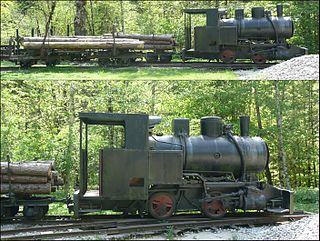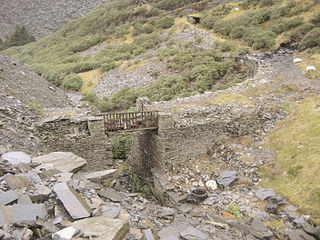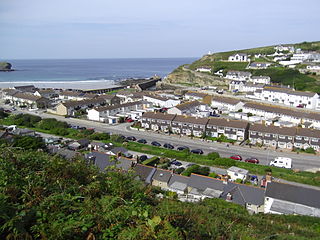
The Birmingham and Gloucester Railway (B&GR) was the first name of the railway linking the cities in its name and of the company which pioneered and developed it; the line opened in stages in 1840, using a terminus at Camp Hill in Birmingham. It linked with the Bristol and Gloucester Railway in Gloucester, but at first that company's line was broad gauge, and Gloucester was a point of the necessary but inconvenient transhipment of goods and passengers onto 4 ft 8+1⁄2 instandard gauge that became the national standard. Nearly all of the original main line remains active as a "trunk" route, also known as an arterial route or line.

Cheltenham Spa railway station serves the spa town of Cheltenham in Gloucestershire, England. Situated on the Bristol–Birmingham main line, it is managed by Great Western Railway, although most services are operated by CrossCountry. The station is about one mile from the town centre. The official name of the station is Cheltenham, however when the station was renamed in 1925, the London, Midland and Scottish Railway chose to add Spa to the station name. It is a regional interchange and the second busiest station in Gloucestershire, as well as one of the busiest railway stations in South West England.

A plateway is an early kind of railway, tramway or wagonway, where the rails are made from cast iron. They were mainly used for about 50 years up to 1830, though some continued later.
The Bristol and Gloucester Railway was a railway company opened in 1844 to run services between Bristol and Gloucester. It was built on the 7 ftBrunel gauge, but it was acquired in 1845 by the 4 ft 8+1⁄2 instandard gauge Midland Railway, which also acquired the Birmingham and Gloucester Railway at the same time.

Leckhampton is a village and a district in south Cheltenham, Gloucestershire, England. The area is in the civil parish of Leckhampton with Warden Hill and is part of the district of Cheltenham. The population of the civil parish taken at the 2011 census was 4,409.

The Devil's Chimney is a rock formation on Leckhampton Hill, south of Cheltenham, Gloucestershire, England.

Tramways are lightly laid industrial railways, often not intended to be permanent. Originally, rolling stock could be pushed by humans, pulled by animals, cable-hauled by a stationary engine, or pulled by small, light locomotives. Tramways can exist in many forms; sometimes simply tracks temporarily placed on the ground to transport materials around a factory, mine or quarry. Many use narrow-gauge railway technology, but because tramway infrastructure is not intended to support the weight of vehicles used on railways of wider track gauge, the infrastructure can be built using less substantial materials, enabling considerable cost savings.

The Bryn Oer Tramway was a horse-worked narrow-gauge railway built in South Wales in 1814.
The Cheltenham and Great Western Union Railway was a railway company intended to link Cheltenham, Gloucester and Swindon, in England. It was authorised in 1836 but it found it very hard to raise money for the construction, and it opened only a part of its line, between Swindon and Cirencester, in 1841. It sold its business to the Great Western Railway, which quickly built the line through to Gloucester in 1845 and Cheltenham in 1847; part of that route was shared with other companies.

The Severn and Wye Railway began as an early tramroad network established in the Forest of Dean to facilitate the carriage of minerals to watercourses for onward conveyance. It was based on Lydney, where a small harbour was constructed, and opened its line to Parkend in 1810. It was progressively extended northwards, and a second line, the Mineral Loop was opened to connect newly opened mineral workings.

The Wye Valley Railway was a standard gauge railway that ran for nearly 15 miles (24 km) along the Lower Wye Valley between the towns of Chepstow and Monmouth, crossing several times between Wales and England. Opened on 1 November 1876, it was leased to, and worked by, the Great Western Railway (GWR), before being fully absorbed by the GWR in 1905.
The Kington Tramway was an early narrow gauge horse-drawn tramway that linked limestone quarries at Burlinjobb near New Radnor in Radnorshire, Wales, to Eardisley in Herefordshire, England.

The Forest of Dean Railway was a railway company operating in Gloucestershire, England. It was formed in 1826 when the moribund Bullo Pill Railway and a connected private railway failed, and they were purchased by the new company. At this stage it was a horse-drawn plateway, charging a toll for private hauliers to use it with horse traction. The traffic was chiefly minerals from the Forest of Dean, in the Whimsey and Churchway areas, near modern-day Cinderford, for onward conveyance from Bullo Pill at first, and later by the Great Western Railway.

Some industrial narrow-gauge railways in the United Kingdom and the Isle of Man were primarily built to serve quarrying, mining, and similar industries. Some of these narrow-gauge railways offered passenger services for employees or workmen, but they did not run public passenger trains. They are listed by the primary industry they served.

The Bicslade Tramroad was a wagonway built by the Severn and Wye Railway (S&WR) in the Forest of Dean, Gloucestershire, England. The first section of the line was opened in 1812 as a branch of the S&WR plateway from Lydney to Lydbrook, which had opened in 1810. It was expanded over time to serve the collieries and quarries in the Bixslade valley ; the last stretch, to Bixhead Quarry, opened in 1855. Stone traffic ceased in 1944 and coal followed in 1946.
The Sirhowy Tramroad was a plateway built to convey the products of ironworks at Tredegar to Newport, South Wales. It opened in 1805 between Tredegar and Nine Mile Point, a location west of Risca, from where the Monmouthshire Canal Company operated a tramroad to Newport. The Sirhowy Tramroad was operated at first by horse traction, but early locomotives were used, and a passenger service was operated.
The Monmouth Railway, also known as the Monmouth Tramroad, was a horse-drawn 3 ft 6 in gauge plateway. It ran for about 5 miles (8.0 km) from Howler's Slade, east of Coleford, in Gloucestershire and Monmouth; there were two branches from other mineral sites. It was intended to bring mineral products of the Forest of Dean to Monmouth, and to the works alongside the River Wye.
The Bristol and Gloucestershire Railway was an early mineral railway, opened in two stages in 1832 and 1834, which connected collieries near Coalpit Heath with Bristol, at the river Avon. Horse traction was used. It was later taken over by the Bristol and Gloucester Railway, and much of the route became part of the main line between Birmingham and Bristol, though that was later by-passed and closed. Part of it now forms the Bristol and Bath Railway Path.

The Avon and Gloucestershire Railway also known as The Dramway was an early mineral railway, built to bring coal from pits in the Coalpit Heath area, north-east of Bristol, to the River Avon opposite Keynsham. It was dependent on another line for access to the majority of the pits, and after early success, bad relations and falling traffic potential dogged most of its existence.

The Portreath Tramroad, or alternatively the Portreath Tramway, was opened in 1815, providing a waggonway route from mines near Scorrier in Cornwall, England, to a port at Portreath. From there, it could be transported to market by coastal shipping. It was later extended to serve the Poldice mine near St Day and became known as the Poldice Tramroad, or Poldice Tramway.

















